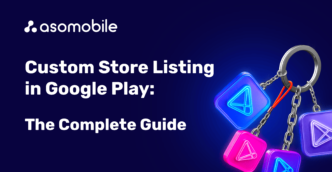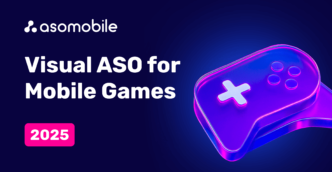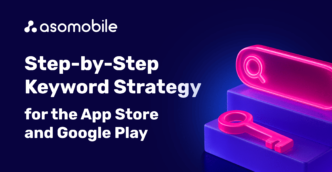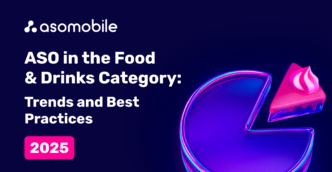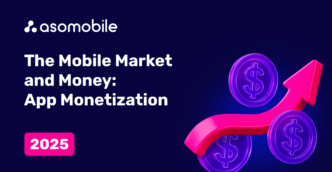Top Mobile App Growth Strategies
Top Mobile App Growth Strategies is the area of mobile marketing we'll dive into now.
Products appear daily as the final form of realized business ideas and projects. But how many of them meet their users? A quality go-to-market process that has been researched and analyzed will increase your chances. Market research helps ensure that a product launch hits the consumer's "right buttons" and that the product idea meets the (often unspoken) desires of the consumer.
Mobile marketing, what is it and why is it needed?
The main objective of mobile app marketing is to sell the services of a mobile product to as many users as possible. But marketing should be a mutually beneficial process for both users and developers - in the context of mobile game and app marketing:
- on the one hand, marketing helps to promote the application on the market among competitors, thereby bringing profit to the app owner
- on the other hand, marketing interests the target audience, making life comfortable by using this particular application
Of course, you can not care about users and worry only about your own income. For example, build an app of average quality, don't update it, don't respond to feedback, don't fix bugs, and generally don't improve the mobile product. Instead, spend money on UA (paid traffic) and conduct aggressive advertising campaigns. The target audience will quickly realize that the application is so-so and will go to more attentive and sensitive competitors. To competitors who competently use marketing and constantly develop their mobile products.
At the end of the article, you can find a 40% discount coupon for the first month of using ASOMobile - a tool for creating ASO and researching competitors in the mobile app market.
Therefore, in mobile app marketing, as elsewhere, the golden mean is important. So that advertising is effective, and that the application itself does not disappoint users.
Happy users are the best advertisement!
Highlights of Mobile App Growth Strategies:
- ASO
- UA (paid traffic)
- Social networks
- Influence marketing (influencers) and their blogs
- E-mail marketing
- Content Marketing and Media Relations
- User retention
- SEO
- KPI, promotion efficiency
More on this is below.
ASO as a source of organic traffic
Without big words, the success of a mobile application directly depends on a competent ASO strategy.
What is ASO?
ASO stands for App Store Optimization. Unlike UA traffic, ASO is free.
Briefly, it looks like this:
- There are mobile application stores, and there are several of them, but the main and most popular ones are the App Store and Google Play or other alternative markets.
- Mobile applications are located on the platforms of these stores.
- And there is a target audience for that this or that application is designed for
- ASO is the tool that draws the attention of users to a particular app. It attracts by increasing the app visibility for the target audience on the App Store and Google Play
What is the main purpose of ASO?
Increase the visibility of the mobile app.
Users enter their request into the search bar of the mobile application store (App Store or Google Play). The store gives them a list of applications that match their request. But it doesn’t give out just like that, but according to a certain algorithm - from the most popular, standing in the first lines of the app store rating and descending to applications hanging in the backyards of the mobile universe.
Organic traffic. What is it and how is it related to ASO?
Let's go through the definitions of the main concepts:
- Organic installation is the one when the user independently found the application and installed it. By “independently” it is understood that the user has not seen the advertisement of the application, and did not go to the application through links from web resources or partner apps. They found it themselves, they installed it themselves, they use it themselves.
- Accordingly, organic traffic is the number of organic installs. The bigger, the better. It is noteworthy that the more often an application is installed organically, the higher it is ranked by the stores.
ASO is just aimed at increasing the app visibility for users. ASO optimizes the app in such a way that, due to the quality of the app itself, it will be suggested more often in response to a user search query.
So, organic traffic is formed by:
- users who independently, without any advertising, found and installed the application. Simply because they are interested in the proposed functionality of the mobile product.
- store recommendations (editors' choice, top picks, etc).
ASO is multifaceted and diverse, but that's not what we are after here. You can read more about ASO here.
UA - paid traffic as a way to promote
After ASO and the organic traffic associated with it, it is logical to move on to paid traffic, aka UA.
What is UA and how does it work?
Everything is prosaic here, paid traffic works for money. The app owner pays to have their product show up in the search results of the stores for a user query. Essentially, for the app to be advertised by the store. You can also attract new users through paid channels like Facebook Ads, TikTok Ads, Google Ads, Apple Search Ads, etc.
A competent UA strategy can increase organic traffic by 1.5 times.

You can, of course, save on UA traffic, but:
- It must be understood that more than 80% of the world's population have mobile phones and spend an average of 5-6 hours a day on them. Add to that almost 2 million apps on the App Store and about 2.5 million mobile products on Google Play. And it becomes obvious that the mobile application market is very, very competitive. There are more and more applications similar in functionality every day. If organic traffic is not yet strong enough, then paid traffic can help move the application off the ground. Remember that UA increases organic traffic by an average of 1.5 times. Where there is organic traffic, there are organic installs. Which in turn increases the visibility of the app to the user audience.
- UA is especially effective for new mobile products. Here, the main vector of the advertising campaign is aimed at brand recognition (branded keywords) and keywords with high search volume. By entering a request, the user, in addition to organic recommendations, sees UA traffic (app brand keywords) in the search results. Subsequently, this leads to an increase in organic traffic, despite the fact that users initially saw paid traffic.
In conclusion, it is worth noting that it is optimal if UA complements ASO. It’s quite nice if UA is used in the context of already existing organic traffic, as an advertisement for new features of a mobile product and to increase user awareness of the app functionality.
Social networks and their use in the promotion of mobile applications
We will not explain here what social networks are. Since the same Facebook, Linkedin, and YouTube are familiar to any mobile phone user.
Why social media and how does it work?
- This is a completely different approach to the client. You will probably agree that in UA and Facebook you can not address the user in the same way. For the same reason, you will have to show your mobile product from a fresh angle.
- Interaction with potential users. Directly. It's livelier than advertising directly in the stores. An app brand has a personality.
- The presence of the app brand in social networks gives the user a sense of brand accessibility. Proximity and liveliness.
The world of the Internet has many social networks. The main thing is to decide which social networks are suitable for a particular application. We take into account the country and the target audience. Based on those, we choose the optimal, within the framework of the marketing strategy, social networks.
By the way, here are the most popular ones:
- YouTube
- TikTok
- Snapchat
What should you pay special attention to?
- It is necessary to make sure that the user who finds you on the social network immediately understands that you have a mobile application. Everything should be as clear as possible.
- Ask yourself the question - is the purpose and benefit of the application clear to the user? Start from your answer.
- App link is required!
Influence Marketing and Blogs
Here we have combined influence marketing and blogs because influence marketing works through influencers, who are mostly bloggers and other personalities known to ordinary users. With the development of blogging as a “special art form”, influence marketing has gained momentum. Even more - this is a real boom in 2022.
In more detail, it looks like this.
Pros:
- the ability to show the target audience the functionality and convenience of the app on practice
- talk about the benefits of using the app
- work through the objections and pains of users
- stimulate the emergence and strengthening of trust in the app brand
- improve the image of the app
- launch a new mobile product on the market, etc.
There are also some disadvantages:
- poor choice of opinion leader
- the difficulty of creating high-quality advertising content. Such that the user thinks that the bloggers did it themselves, and not professionals in the field of advertising. There must be a live connection between the target audience and the opinion leader
- freedom in the actions of a blogger can lead to a complete failure. Just because they are people, not an advertising machine. Therefore, you should discuss with the opinion leaders at least their main actions.
What to pay attention to?
- Goals determine the opinion leader. If you need to promote the brand of the application, then you should go to universal celebrities. If the task is to cover the widest possible target audience, then the path lies with millionaire bloggers. It is worth remembering that the prices of such opinion leaders bite.
- The amount of influencer marketing. Usually, an influencer is used once, but sometimes more is needed. Decide at this moment.
- Budget. Opinion leaders are free, and are exorbitantly expensive. Allocate a budget that you are willing to spend on an influencer and then select an influencer according to it.
Influence marketing, with opinion leaders and their blogs, as well as the promotion of applications in social networks, is modern, and most importantly, effective advertising.
E-mail marketing
- With the help of special constructor services, a letter of the required content is assembled:
- greetings
- announcement
- a favor to leave a review
- festive
- dedicated to an event, seasonal, to date, etc.
- Then it is sent to recipients (you can use databases or enter addresses manually)
What are the purposes of E-mail marketing?
- lead generation
- increasing user engagement
- the ability to collect user data for personalized advertising
- increase in conversion into useful action (for example, app installs)
- When is the best time to send an email?
6 in the morning, simply because many people check the emails accumulated overnight - 10 am, the beginning of the working day begins with checking mail and instant messengers
- 14:00, lunch with the smartphone
- 20:00-24:00, people are not busy, looking through the notifications collected during the day, usually at night
This is in short. Now there is a significant number of services that help to competently and accurately organize Email marketing. Don't neglect this opportunity.
Content Marketing and Media Relations
Content and media go hand in hand. One is impossible without the other.
The mobile app marketer begins to distribute content about the mobile app along with its launch. A professional would do that a few months before. You can start a blog and post content about the application - useful and interesting. Screenshots, and videos, describe the functionality and work with the pain of users.
With content, plus/minus is clear, but what about the media? The media have long ceased to be only print, all have moved to the Internet.
As usual, the most important thing is to decide on the right media.
How to do it?
- Explore the coverage of the target audience of the media. Nuance - pay special attention to regional media, they give a good influx of local users.
- Record and track audience engagement. Even the most beautiful, but not read by users, content is a blank shot.
- Select relevant media. If in the media mainly political content is read, then posting information about the navigation application here is clearly not worth it.
- Synergy. The selected media and app brand should ideally have identical values.
NB! The content can be further used for Email distribution and work on social networks.
User Retention
It is not enough to attract new users, they must be retained. It makes no sense if the user has installed the application, but does not use it. Here “does not use” = “does not make a profit”.
Retention (user retention rate) shows how many users return to the application after installing it. Here, as usual, the more the better.
Here are the practical steps:
- Maintain quality two-way communication. Send valuable information to the user in messages within the application. This may be information about updates, new features, etc.
- Stimulate users with push notifications. Special promotions, premium access, extended functionality, etc.
- Offer users the opportunity to leave feedback about the application. Increase the self-worth of the user, it's nice for everyone.
SEO
SEO is like ASO for mobile app stores, only for search engines like Google, Yahoo!, etc. SEO is, first of all, textual content optimization. Selection of relevant keywords that the user can use to search for, in our case, the application.
So, there are two main channels for attracting incoming traffic to the mobile application page:
- The first and most obvious is directly the stores - App Store or Google Play
- The second is through a search engine. It's important to get your SEO right.
How does it work?
The user searches for information through a web resource search engine. Properly configured SEO provides the users with a link to an application that is relevant to their request on the App Store or Google Play sites. Thus, the users go to the required store space, although they did not originally intend to go there.
Important! The presence of relevant keywords in the title and description of the application is required.
KPI, promotion efficiency
You have done everything possible and impossible to promote your mobile product. What's next? How to understand whether everything possible has been done or if there are still ways to improve? And how to evaluate the effectiveness of already applied means of promotion?
Here are three main groups of metrics for evaluating the success and effectiveness of a mobile app marketing campaign:
- Growth metrics talk about the number of unique users for a certain period:
- MAU (Monthly Active Users) - per month
- WAU (Weekly Active Users) - per week
- DAU (Daily Active Users) - per day
- Sticky factor or Stickiness - the frequency of using the application
- Lifetime - the average number of days during which the user accesses the application
- Return or acquisition metrics show the percentage of users who use the application after installing it. There are three main return periods:
- Return or acquisition metrics show the percentage of users who use the application after installing it. There are three main return periods:
- Day 1 retention
- Day 7 retention
- Day 28/30 retention
- and Rolling Retention (repeated retention)
- Monetization metrics characterize the financial success of the app:
- Paying Share - total number of revenue-generating users
- ARPU - average revenue per user
- Cumulative ARPU (CARPU) - cumulative ARPU for a certain period
- LTV is the average income from one user for the entire time of using the application
Instead of conclusions
In this article, we have covered the TOP areas of mobile app marketing. A separate article about each of the directions can be written, here we conveyed only the main essence.
Most importantly, all these areas are related. Working with one of them, you will definitely influence the other. Some areas are generally logical to work out in tandem. Somewhere from one direction, you can take information for another, for example, content.
Experiment, mix and match marketing directions with each other. Look for new ways to reach your goals.
 Українська
Українська  Русский
Русский  Español
Español 
